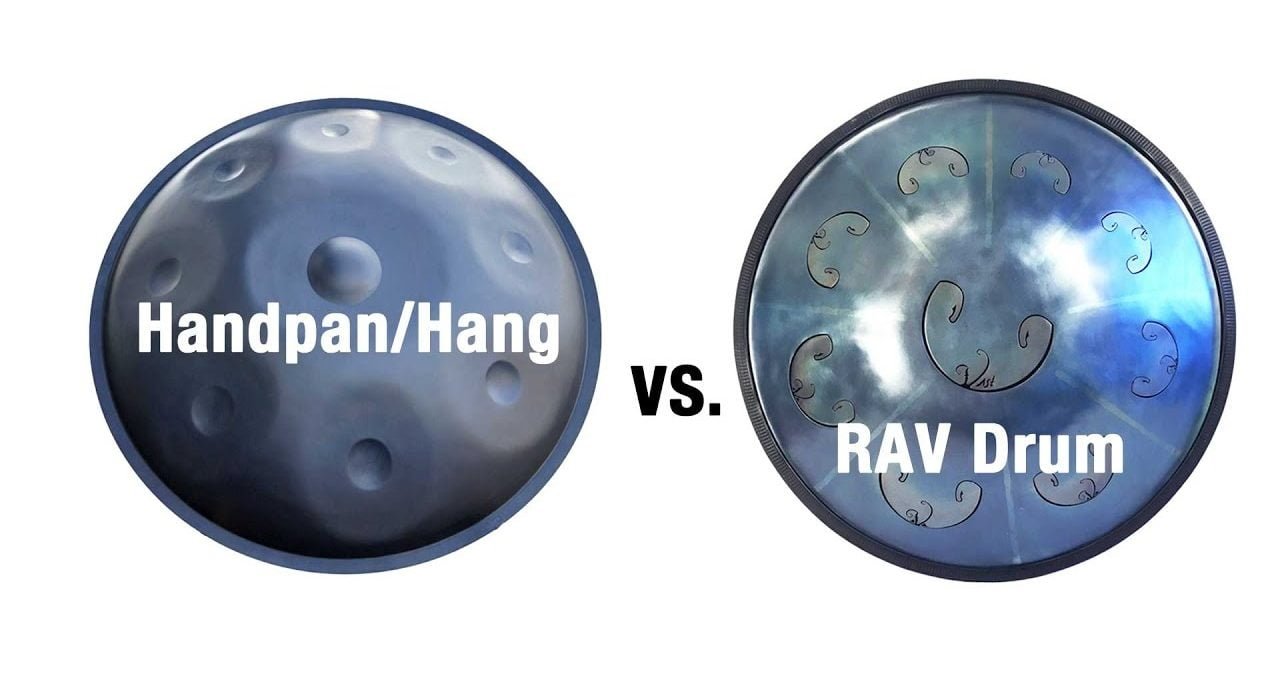There are many similarities and differences between steel tongue drum vs handpan. Both instruments are played with the hands, and both can produce a range of beautiful, relaxing sounds.
Steel tongue drums are generally smaller and more portable than handpans, making them a great choice for travel or for taking to the park or beach. They also tend to be more affordable than handpans.
On the other hand, handpans offer a wider range of sounds and are better suited for complex compositions. They are also more fragile and require more care when handling.
Key Points for Matching Differences
- Origin and History: While the steel tongue drum has roots in the slit drum, the handpan is a more recent invention, inspired by the steelpan from Trinidad and Tobago.
- Construction and Design: The steel tongue drum features cut-out tongues on a rounded steel surface, whereas the handpan presents a convex shell with hammered indentations representing different notes.
- Playing Techniques: Steel tongue drums can be played using mallets or fingers, offering a softer, more intimate sound. In contrast, handpans are primarily played with the hands, utilizing various parts of the palm and fingers to elicit a wider range of dynamics.
- Sound and Resonance: Steel tongue drums produce a clear, bell-like tone with a lingering resonance, while handpans offer a rich, complex sound with a broader spectrum of harmonics and overtones.
- Tuning and Scales: Steel tongue drums often feature predefined scales, making them accessible for beginners. Handpans, however, offer more flexibility with tunings, catering to both beginners and seasoned musicians seeking to explore diverse musical scales.
- Learning Curve: Steel tongue drums generally present a gentler learning curve, making them ideal for beginners. Handpans, with their wider range of tones and playing techniques, might offer a deeper, more complex journey for experts.
- Price Range: Steel tongue drums are generally more affordable, making them a popular choice for beginners. Handpans, given their complex construction and craftsmanship, tend to be on the higher end of the price spectrum.
How To Choose A Steel Tongue Drum?
Looking for a steel tongue drum? Also called tank drums, steel tongue drums are unique musical instruments that are perfect for both beginners and experienced musicians alike. Here are a few tips on how to choose the right steel tongue drum for you:
- 1. Decide what size steel tongue drum you want. Steel tongue drums come in a variety of sizes, from small to large. Smaller drums are more portable and easier to play, while larger drums have a deeper, more resonant sound.
- 2. Consider what type of music you want to play. Steel tongue drums can be used for a variety of genres, from relaxation and meditation to upbeat and energetic rhythms.
- 3. Choose a steel tongue drum with the right accessories. Most steel tongue drums come with a mallet or beater, but you may also want to purchase a stand or case to protect your investment.
- 4. Select a steel tongue drum with the right finish. Steel tongue drums are available in a variety of finishes, from natural wood to bright colors. Consider what will look best in your home or studio.
- 5. Determine your budget. Steel tongue drums range in price, from around $100 to $1,000.
Handpan vs Tongue Drum vs Tongue Pan: What’s the Difference?
Tank Drum Vs Tongue Drum
There are many similarities between tank drums and tongue drums, but there are also some important differences.
- Both types of drums are percussion instruments that are played with the hands.
- Both drums have a deep, resonant sound that can be used for a variety of music genres, including folk, rock, and world music.
The main difference between tank drums and tongue drums is the way they are played. Tank drums are played by striking the drum with the palms of the hands, while tongue drums are played by striking the drum with the tongues.
[azonpress template=”widget” asin=”B08SJ8DZDG”]This difference in playing technique results in a different sound for each type of drum.
Tank drums typically have a more mellow sound, while tongue drums tend to have a sharper, more penetrating sound. Tongue drums also have a wider range of pitches than tank drums.
Another difference between these two types of drums is their size. Tank drums are much larger than tongue drums, which makes them more difficult to transport and store.
If you’re looking for a deep, resonant sound, either type of drum would be a good choice. If you’re looking for a more piercing sound, tongue drums may be the better option.

Handpan/Pan Drum Comparison: Meinl Sonic Energy Steel Tongue Drum vs. RAV Vast vs. Aura Handpan
Best Tongue Drum For Beginners
- 1. Remo Ocean Drum.
- 2. Meinl Percussion Tongue Drum.
- 3. Alesis Strike Tongue Drum.
- 4. Roland RT-30K.
- 5. Yamaha DTX400K.
👉 HANDPAN vs Steel Tongue DRUM 👈
What To Consider For Newbies & Experts to choose the right tongue drum?
1. Scale and Tuning
- Beginners: Choose a drum with a pentatonic scale, which doesn’t have any wrong notes and makes it easy to create harmonious music.
- Experts: Consider a drum with a chromatic scale or a scale that complements your existing musical projects.
2. Number of Notes
- Beginners: Start with a drum that has 8-9 notes, which will provide a sufficient range to learn and experiment without being overwhelming.
- Experts: Opt for a drum with 11-13 notes to have a wider range of tones and possibilities for complex compositions.
3. Material and Craftsmanship
- Beginners: A drum made of steel or a quality alloy, which is both durable and capable of producing good sound.
- Experts: Look for a drum crafted by a reputable maker, possibly with custom materials and craftsmanship for a unique sound character.
4. Tone and Resonance
- Beginners: Choose a drum with a clear, resonant tone that sustains well, making it easier to produce pleasing sounds.
- Experts: Consider a drum with a complex tone and the ability to produce subtle overtones and harmonics for a richer sound experience.
5. Size and Portability
- Beginners: A smaller, more portable drum (around 10 inches in diameter) would be easier to handle and transport.
- Experts: Depending on your performance needs, you might opt for a larger drum (12-14 inches) for a fuller sound, if portability is not a concern.
6. Accessories
- Beginners: Ensure it comes with necessary accessories like mallets and a carrying case to get started easily.
- Experts: You might want to invest in high-quality accessories, like specialized mallets and a sturdy case for protection and transportation.
7. Budget
- Beginners: You can find decent quality drums in the range of $100-$200 that is suitable for learning.
- Experts: Be prepared to invest upwards of $300-$500 or even more for a professional-grade drum with superior craftsmanship and sound quality.
8. Reviews and Recommendations
- Beginners: Look for drums with positive reviews and recommendations, particularly from other beginners.
- Experts: Seek out recommendations from professional musicians or communities dedicated to tongue drums for informed choices.
9. Hands-On Experience
- Beginners: If possible, try playing a few different drums in a store to find one that feels right to you.
- Experts: You might want to attend workshops or events where you can try out different drums and learn from experienced players.
Suggested Choices
For Beginners:
- Lronbird Steel Tongue Drum: Affordable and comes in various scales suitable for beginners.
- Pyle Professional Pan Drum: A well-reviewed choice that is budget-friendly and offers good sound quality.
For Experts:
- GUDA DRUM Freezbee: A higher-end option with excellent craftsmanship and sound quality.
- Idiopan Domina 12-Inch Tunable Steel Tongue Drum: Offers the ability to tune to different scales, providing versatility for more experienced players.
Kosmosky Tongue Drum
The Kosmosky tongue drum is a unique and beautiful instrument that is perfect for those who want to create calming and relaxing music. This drum is made from premium quality materials, and it has a lovely and peaceful sound that is perfect for meditating or simply unwinding.

Steel Drum Comparison (Hapi, Kaizen, RAV, handpan
Best Tongue Drum for beginners
When it comes to finding the best tongue drum for beginners, there are a few things you need to take into account.
- First and foremost, you need to make sure that the drum you choose is the right size for you. If you’re a bit taller, you might want to choose a larger drum.
- Secondly, you’ll need to make sure that the drum is made of the right material. For beginners, it’s best to choose a drum that’s made of wood or metal.
What is? Tongue Drum Tank Drum Tongue Pan – which and what to buy.
Rav Drum Vs Tongue Drum
Rav drum:
- 1. Has a more mellow and deeper sound than the tongue drum.
- 2. Is played with sticks, while the tongue drum is played with the fingers or hands.
- 3. Is bigger in size than the tongue drum.
- 4. Is usually made of wood, while the tongue drum can be made of different materials.
- 5. Has a more complex sound, while the tongue drum has a simpler sound.

Hang/Handpan vs. RAV Drum Comparison
Handpan Steel Drum
Handpan steel drums are a type of musical instrument that is played by striking the surface with the hands. The handpan is a steel drum that is played with the hands, similar to a drum set.
The instrument is made of two steel hemispheres that are welded together and have a diameter of about 18 inches (46 cm).
The top hemisphere has a hole in the center and is covered with a skin, usually made of goatskin. The bottom hemisphere is left open.
The handpan is played by holding it in the lap or on a stand and striking the surface with the hands. The instrument can be played with one hand or two hands.
The player can produce a variety of sounds by striking different parts of the surface with different parts of the hand. The handpan can also be played with percussion mallets.
The handpan is a relatively new instrument that has only been around for a few years. The instrument was invented in Switzerland in the early 2000s.
The first handpans were made by welding together two steel hemispheres. The instrument has since been mass-produced and is now available in a variety of sizes and colors.
Steel Tongue Drum
Introduction
The steel tongue drum, also known as a tank drum or hank drum, is a percussive instrument crafted from a propane tank or steel disc. It consists of a hollow, rounded steel chamber with cut-out “tongues” of varying lengths and sizes, which produce different tones when struck.
Construction and Design
- Material: Usually made from steel or other metals.
- Shape: Generally round, resembling a UFO.
- Tongues: The top surface features cut-out tongues, each representing a different note.
- Size: Varies, but commonly found in diameters ranging from 8 to 14 inches.
Playing Techniques
- Mallets: Often played with mallets, which can be rubber or felt-tipped to produce different tones.
- Fingers: Can also be played with fingers for a softer, more intimate sound.
- Harmonics: Players can explore harmonics by striking the tongues at different points and with varying techniques.
Tuning
- Scale: Typically tuned to a specific scale, such as pentatonic or diatonic, allowing for melodic play.
- Custom Tuning: Some models allow for custom tuning, enabling players to explore different musical scales.
Maintenance
- Cleaning: Regular cleaning with a soft cloth to remove fingerprints and dust.
- Protection: Store in a protective case to prevent dings and scratches.
- Tuning Maintenance: Over time, retuning may be necessary to maintain the desired pitch.
Handpan
Introduction
The handpan is a relatively new instrument, developed in the 2000s, inspired by the steelpan from Trinidad and Tobago. It consists of a rounded steel shell with a series of tuned notes hammered into its surface.
Construction and Design
- Material: Often made from steel, but can also be found in other metals.
- Shape: Resembles a flying saucer, with a convex top (called the “Ding”) and a flat bottom (called the “Gu”).
- Notes: The top surface features a central note (the “Ding”) surrounded by a series of tuned notes.
Playing Techniques
- Hands: Played with the hands, using the fingertips, thumbs, or the heel of the hand to strike the notes.
- Dynamics: Players can explore dynamics by varying the force of their strikes.
- Harmonics: Similar to the steel tongue drum, players can explore harmonics and overtones.
Tuning
- Scale: Handpans are tuned to specific scales, allowing for melodic and harmonic play.
- Custom Tuning: Some makers offer custom tuning, enabling players to choose their preferred scales.
Maintenance
- Cleaning: Regular cleaning with a soft cloth and occasionally with a specific cleaner to prevent rust and tarnish.
- Protection: It’s recommended to store the handpan in a hard case to protect it from damage.
- Humidity Control: Using a dehumidifier packet in the case can help prevent rust.
Static Functions and Details
Resonance and Sustain
Both instruments are known for their resonance and sustain, producing lingering tones that create a meditative atmosphere.
Therapeutic Uses
These instruments are often used in sound therapy and meditation due to their calming and harmonious sounds.
Community and Learning
Both instruments have fostered vibrant communities of players and enthusiasts, with many resources available for learning and collaboration.
Accessibility
Both the steel tongue drum and handpan are accessible to beginners, with many finding joy in the instruments’ intuitive playability and soothing tones.
I hope this gives you a comprehensive overview of steel tongue drums and handpans. They are truly fascinating instruments with a lot to explore!
BeatRise TonguePan Unboxing and Review | Handpan or Steel Tongue Drum?
What’s The Difference Between A Tongue Drum And A Hang Drum?
Tongue drums and Hang drums are both percussion instruments that are played with the hands. The main difference between the two is the size and shape of the instrument.
Tongue drums are typically smaller and have a cylindrical shape, while Hang drums are larger and have a convex shape. Both instruments can be played with a variety of techniques, and each produces a unique sound.
Is Steel Tongue Drum The Same As A Steel Drum?
No, a steel tongue drum is not the same as a steel drum. A steel tongue drum is a percussion instrument that is played with the hands, while a steel drum is a percussion instrument that is played with sticks.
Is The Steel Tongue Drum Easy To Play?
The steel tongue drum is a new instrument that is becoming increasingly popular. It is easy to play and has a very soothing sound. The steel tongue drum is also known as a hank drum or a tank drum.
It is a round metal drum that has a steel tongue in the center. The steel tongue drum is played by striking the tongue with a mallet.
The sound of the steel tongue drum is similar to that of a steel drum. The steel tongue drum is very easy to play and is a great instrument for relaxation and meditation.
Does A Tongue Drum Sound Like A Steel Drum?
A tongue drum is a percussion instrument that is played with the hands. The drum is made of wood, metal, or plastic and has a concave shape. The tongue drum produces a sound that is similar to a steel drum.
Conclusion
The steel tongue drum is a great option for those looking for a unique instrument with a mellow sound. The handpan is a great option for those looking for a more versatile instrument with a brighter sound.



